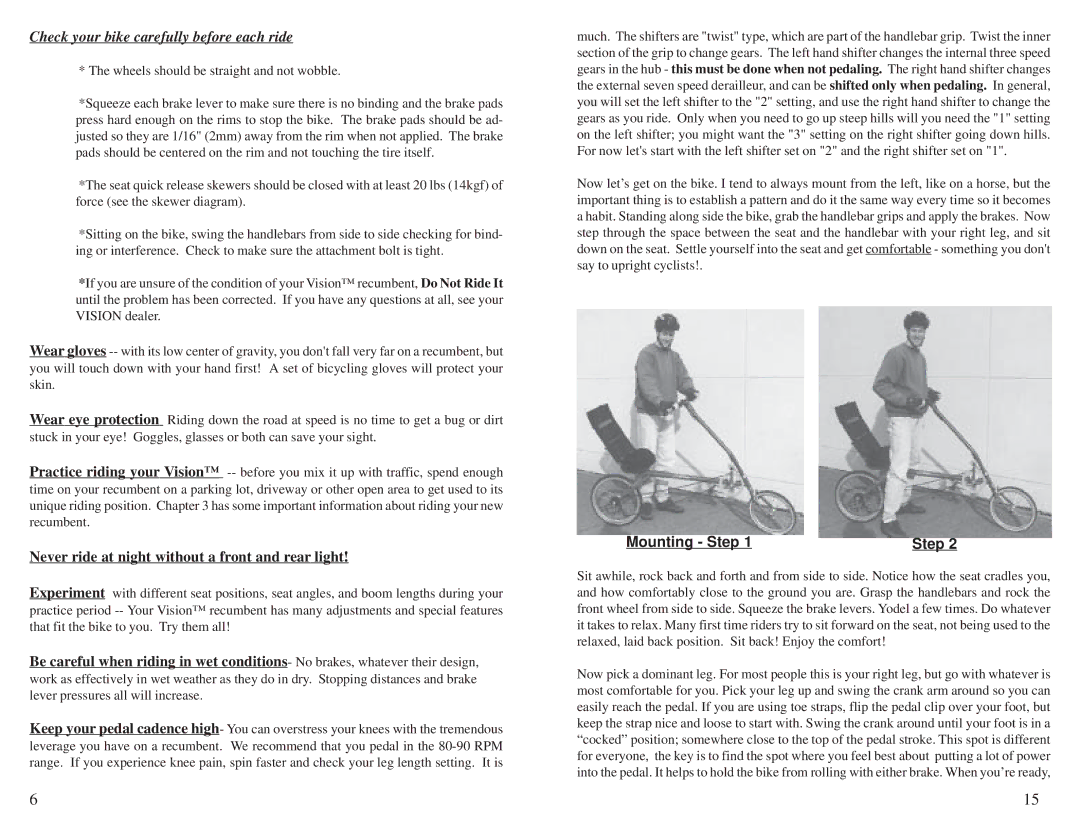
Check your bike carefully before each ride
* The wheels should be straight and not wobble.
*Squeeze each brake lever to make sure there is no binding and the brake pads press hard enough on the rims to stop the bike. The brake pads should be ad- justed so they are 1/16" (2mm) away from the rim when not applied. The brake pads should be centered on the rim and not touching the tire itself.
*The seat quick release skewers should be closed with at least 20 lbs (14kgf) of force (see the skewer diagram).
*Sitting on the bike, swing the handlebars from side to side checking for bind- ing or interference. Check to make sure the attachment bolt is tight.
*If you are unsure of the condition of your Vision™ recumbent, Do Not Ride It until the problem has been corrected. If you have any questions at all, see your VISION dealer.
Wear gloves
Wear eye protection Riding down the road at speed is no time to get a bug or dirt stuck in your eye! Goggles, glasses or both can save your sight.
Practice riding your Vision™
Never ride at night without a front and rear light!
Experiment with different seat positions, seat angles, and boom lengths during your practice period
Be careful when riding in wet conditions- No brakes, whatever their design, work as effectively in wet weather as they do in dry. Stopping distances and brake lever pressures all will increase.
Keep your pedal cadence high- You can overstress your knees with the tremendous leverage you have on a recumbent. We recommend that you pedal in the
much. The shifters are "twist" type, which are part of the handlebar grip. Twist the inner section of the grip to change gears. The left hand shifter changes the internal three speed gears in the hub - this must be done when not pedaling. The right hand shifter changes the external seven speed derailleur, and can be shifted only when pedaling. In general, you will set the left shifter to the "2" setting, and use the right hand shifter to change the gears as you ride. Only when you need to go up steep hills will you need the "1" setting on the left shifter; you might want the "3" setting on the right shifter going down hills. For now let's start with the left shifter set on "2" and the right shifter set on "1".
Now let’s get on the bike. I tend to always mount from the left, like on a horse, but the important thing is to establish a pattern and do it the same way every time so it becomes a habit. Standing along side the bike, grab the handlebar grips and apply the brakes. Now step through the space between the seat and the handlebar with your right leg, and sit down on the seat. Settle yourself into the seat and get comfortable - something you don't say to upright cyclists!.
Mounting - Step 1 | Step 2 |
Sit awhile, rock back and forth and from side to side. Notice how the seat cradles you, and how comfortably close to the ground you are. Grasp the handlebars and rock the front wheel from side to side. Squeeze the brake levers. Yodel a few times. Do whatever it takes to relax. Many first time riders try to sit forward on the seat, not being used to the relaxed, laid back position. Sit back! Enjoy the comfort!
Now pick a dominant leg. For most people this is your right leg, but go with whatever is most comfortable for you. Pick your leg up and swing the crank arm around so you can easily reach the pedal. If you are using toe straps, flip the pedal clip over your foot, but keep the strap nice and loose to start with. Swing the crank around until your foot is in a “cocked” position; somewhere close to the top of the pedal stroke. This spot is different for everyone, the key is to find the spot where you feel best about putting a lot of power into the pedal. It helps to hold the bike from rolling with either brake. When you’re ready,
6 | 15 |
